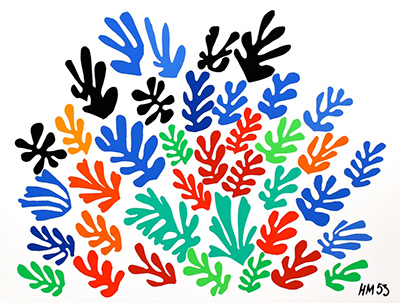In 1941 Matisse was diagnosed with cancer and following surgery, became almost bedridden. However, Matisse’s extraordinary creativity was not hampered for long.
He started using a wheelchair and following an operation, gained fresh inspiration and a new lease of life during the final 14 years of his life.
Matisse’s newfound energy led to an explosion of expression, the result of half a century of work and a radical renewal that enabled him to create what he had always yearned for – artistic freedom.
A master with scissors, Matisse began producing gouaches découpés from his studio bed. Vast in scale, lush colour, his collage cut-outs are among the most admired and influential works of Matisse's entire career. He invented a systematic approach to the technique for the production of his cut-outs.
Linel gouaches were firstly brushed on to sheets of white paper. Under Matisse’s direction, Lydia Delectorskaya, his studio assistant, loosely pinned the silhouettes of birds, fish, and marine vegetation directly onto the walls of the room. Matisse then cut out elements of the gouache sheets and placed them into arrangements. The Linel gouaches were used because they “directly corresponded to commercial printers’ ink colours” and would reproduce perfectly. The bright, vibrant Linel colours pulsated with energy.
Among his first explorations with paper cut-outs was a book called Jazz, which Matisse prepared during the war but which was only published in 1947. The production of Matisse’s collage cut-outs steadily increased following the publication of Jazz, and eventually led to the creation of mural-size works which took up whole walls.
Completed 1953, The Sheaf (La Gerbe) is one of Matisse's later collages – a Gouache on paper, cut and pasted on to a background and then mounted on canvas. Measuring 2.94m x 3.5m, this picture is a large-scale work of coloured fronds on a white background. The Sheaf was a design for a ceramic work of the same name commissioned by Mr & Mrs Sidney Brody for their courtyard.




